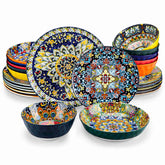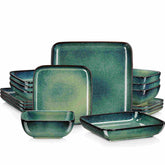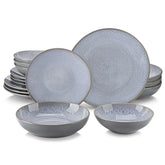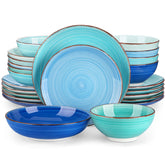The Influence of Stoneware Dinnerware Sets on Dining Experience: A Psychological Perspective
The psychology of tableware is a fascinating subject that explores how the design, material, and color of our plates, glasses, and cutlery can influence our dining experience. From the moment we sit down at a table, the tableware we use can affect our perception of the food and drinks we consume, as well as our overall enjoyment of the meal.
The Allure of Stoneware: Design and Material Enhancements
One type of tableware that has gained popularity in recent years is stoneware dinnerware sets. Stoneware is a type of clay that is fired at high temperatures, resulting in a dense and durable material that is perfect for creating dishes and serving pieces. Stoneware sets are known for their rustic, earthy look and feel, as well as their ability to retain heat, making them ideal for serving hot dishes.
The use of stoneware sets in a dining experience can have a significant impact on the overall perception of the meal. The natural and earthy tones of stoneware can create a warm and welcoming atmosphere, making guests feel more relaxed and comfortable. The weight and texture of stoneware dishes can also add to the tactile experience of the meal, creating a more sensory and engaging experience.
Furthermore, the color of tableware can also play a role in our perception of food and drinks. For example, studies have shown that blue tableware can enhance the taste and aroma of food, while red tableware can increase our appetite and encourage us to eat more. The natural colors of stoneware dinner sets, such as brown, beige, and gray, can create a more organic and authentic dining experience, which can enhance the enjoyment of the meal.
Color and Atmosphere: How Tableware Influences Appetite and Interaction
In addition to the color and texture of stoneware sets, the design and shape of the pieces can also influence our dining experience. For example, a large, round stoneware serving platter can create a more communal and social atmosphere, encouraging guests to share and interact with one another. On the other hand, individual stoneware plates and bowls can create a more intimate and personalized dining experience.
Another aspect of the psychology of tableware is the way it can affect our perception of portion sizes. The size and shape of plates and bowls can influence how much food we perceive to be on our plate, and can even affect our sense of fullness. For example, using smaller plates and bowls set can make it appear as though there is more food on our plate, which can help us feel more satisfied with our meal.
In addition to stoneware sets, the use of different types of tableware can also influence our perception of the food and drinks we consume. For example, using elegant and sophisticated tableware, such as fine china and crystal glasses, can create a more formal and special dining experience, while using simple and casual tableware, such as ceramic plates and mason jars, can create a more relaxed and informal atmosphere.
Sustainability and Conscious Dining: Embracing Eco-Friendly Choices
Furthermore, the use of sustainable and eco-friendly tableware can also enhance our dining experience by making us more aware of our impact on the environment. Using recycled or biodegradable tableware can create a more conscious and mindful dining experience, encouraging us to consider the impact of our choices on the planet.
The psychology of tableware also extends to the way we use it in our daily lives. For example, the way we set our table can affect our mood and mindset as we prepare to eat. Setting a beautiful and inviting table can create a sense of anticipation and excitement for the meal ahead, while a cluttered and disorganized table can create a sense of chaos and stress.
In conclusion, the psychology of tableware is a complex and thought-provoking subject that underscores the significant impact our dining environment has on our perception of food and drinks. The use of stoneware sets can foster a natural and organic dining experience, enhancing meal enjoyment with their beautiful and durable qualities. Their natural colors, textures, and designs create a warm and welcoming atmosphere, encouraging relaxation and connection. However, to craft a dining experience that is both enjoyable and meaningful, it is crucial to consider all aspects of tableware—color, texture, design, and sustainability. By being mindful of these elements and the way we set our table, we can create an intentional and fulfilling dining experience that nourishes both body and soul. Being present and mindful during our meals strengthens our connection with our food, drinks, and those around us. The psychology of tableware raises awareness about the influence of our dining setting on our overall experience, guiding us to make choices that enhance appreciation and enjoyment, while also fostering a deeper connection with people and the world.
*Updated in January 2025










